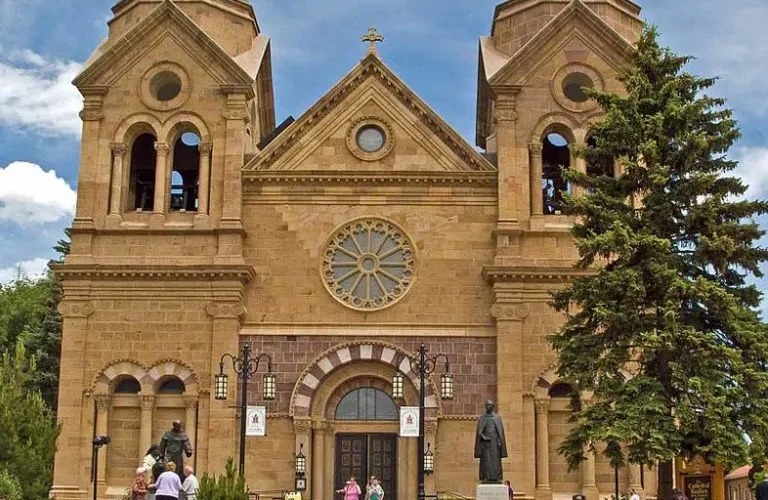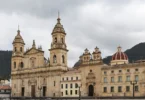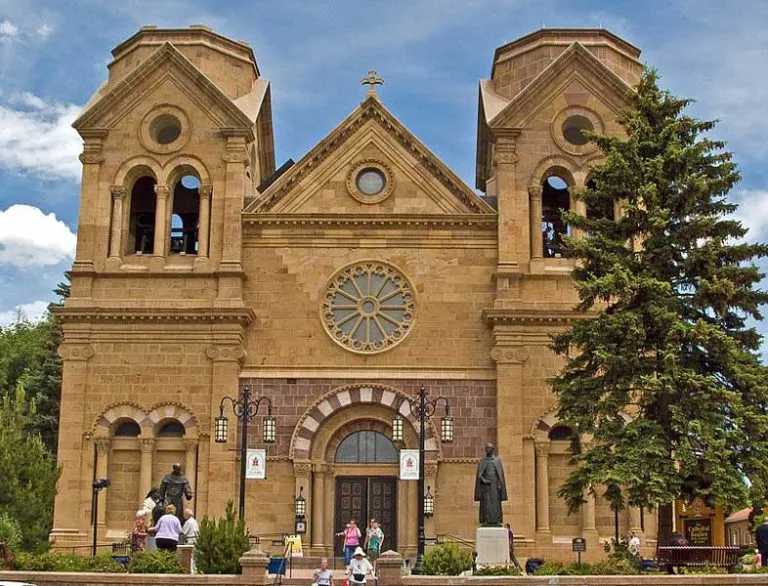
Introduction
The Cathedral Basilica of Saint Francis of Assisi (Spanish: Catedral basílica de San Francisco de Asís), commonly known as Saint Francis Cathedral, is a Roman Catholic cathedral in downtown Santa Fe, New Mexico. It is the mother church of the Archdiocese of Santa Fe.
While the Americas were still in the process of being colonized, La Conquistadora was brought from Mexico City by Fray Alonso de Benavides to Santa Fe de Nuevo México. This is when she referred to as Nuestra Señora de La Asunción (Our Lady of the Assumption). Her role would be as a figure of comfort for new colonists.
This role would be short-lived, however, once she would become the traveling companion of future governor Don Diego de Vargas. Renamed La Conquistadora, she was brought back from El Paso del Norte by de Vargas as he mounted a reconquest of New Mexico from the Pueblo peoples of the area. With carrying the statue on his travels, de Vargas hoped that the lands would be taken back in a relatively bloodless manner.
History of Cathedral Basilica of St. Francis of Assisi, Santa Fe
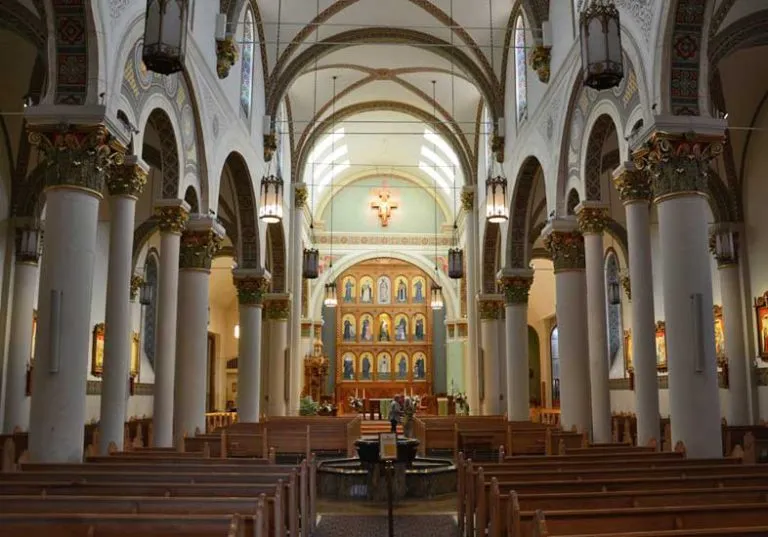
The cathedral was built by Archbishop Jean Baptiste Lamy between 1869 and 1886 on the site of an older adobe church, La Parroquia (built in 1714–1717). An older church on the same site, built in 1626, was destroyed in the 1680 Pueblo Revolt. The new cathedral was built around La Parroquia, which was dismantled once the new construction was complete. A small chapel on the north side of the cathedral was kept from the old church.
Influenced by the French-born Archbishop Lamy and in dramatic contrast to the surrounding adobe structures, Saint Francis Cathedral was designed in the Romanesque Revival style. As such, the cathedral features characteristic round arches separated by Corinthian columns and truncated square towers. The large rose window in front and those of the Twelve Apostles in the lateral nave windows were imported from Clermont-Ferrand in France.
The towers were originally planned to be topped with dramatic 160-foot (49 m) steeples, but due to lack of funds, these were never built. The north tower is a single row of bricks taller than the south tower. The cathedral was built from yellow limestone blocks quarried near the present site of Lamy. A 2005 addition to the upper façade of the cathedral is a small, round window featuring a dove, the symbol of the Holy Spirit. It is a stained glass replica of the translucent alabaster window designed in the 17th century by the Italian artist Bernini for St. Peter’s Basilica in Vatican City.
The Cathedral of Saint Francis of Assisi was officially elevated to a basilica by Pope Benedict XVI on October 4, 2005.
La Conquistadora (Our Lady of the Conquest)
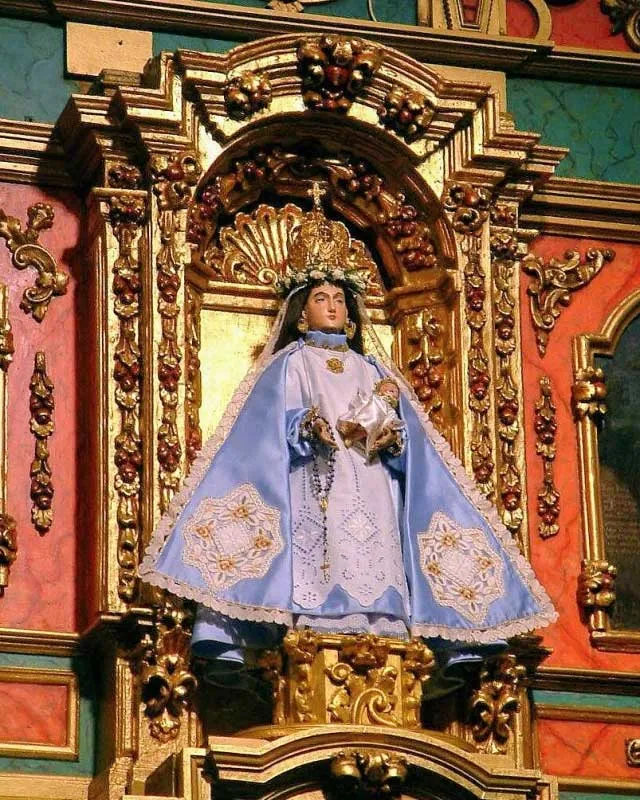
La Conquistadora (Our Lady of the Conquest or Our Lady the Conqueror) is a small wooden statue of the Madonna and Child now in the Cathedral Basilica of St. Francis of Assisi in Santa Fe, New Mexico. She was the first Madonna brought to what is now the United States. The statuette is carved out of wood, and measures approximately three feet in height.
A Catholic confraternity called, La Cofradía de La Conquistadora, exists to “promote devotion to the Mother of God under the title of La Conquistadora – Our Lady of Peace, and for the upkeep and maintenance of both of her chapels at the Cathedral Basilica of St. Francis of Assisi and the Rosario Chapel”.
This confraternity is also responsible for maintaining the icon’s chapel located in the north transept of the Basilica. The icon is dressed by the sacristana, or sacristan who maintains the vast wardrobe that includes clothing, veils, crowns, jewels and wigs. Cancer survivors often donate hair for use in fashioning wigs worn by the statue. The garments that the icon is clothed in are often sewn and donated by the faithful; all are rich in detail and very fine, often with elaborate designs. The estimate of her total outfits is close to 300.
Even non-Catholics find occasion to honor the statue. For example, actress Ali MacGraw commissioned a piece that was displayed at Santa Fe’s Spanish Colonial Museum in an exhibit about the icon mounted during 2010. The statue’s origins are not well-known, but the 15th and 17th centuries are the most likely possibilities. Her arrival into America was made possible by the Spanish, who carried several versions of The Virgin Mary with them on their travels. There is a long history of armies carrying statues of saints into battle, for various purposes.
Although the exact date of the statue’s arrival in the New World is unknown, the Madonna was brought to New Mexico via Mexico City by priest Fray Alonso de Benavides, arriving in Santa Fe on January 25, 1626. Benavides wrote about this date in his journal, but the Archdiocese commonly uses the date of 1625. La Conquistadora was originally known as Our Lady of the Assumption.
Each new generation gave The Virgin a new title, with the current title being given to her by Don Diego de Vargas after he had reclaimed the area of Santa Fe 12 years after the Pueblo Revolt of 1680. He believed that La Conquistadora would help him in battle and offer assistance against the Native Americans who controlled the land. To give thanks to La Conquistadora, the Fiesta de Santa Fe is now held every August, in which she is carried in procession to Rosario Chapel and solemn masses are held in her honor. Another title was given to the statue in 1992, when then-Archbishop Robert Sanchez bestowed her with the name Our Lady of Peace.
On 26 June 1960, the image is granted a canonical coronation by Pope John XXIII, presided over by Archbishop Egidio Vagnozzi, Apostolic Delegate to the country.
Appearance
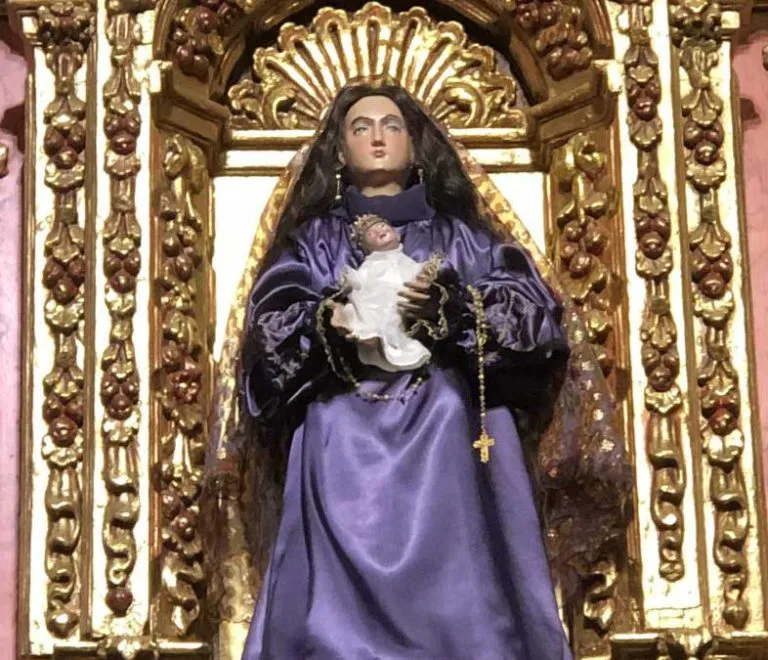
The statue of La Conquistadora is slightly less than three feet, at approximately 30 inches of height. She typically is adorned with a dark brown wig, which is often covered by a long veil. Sometimes the wig’s length rivals her body’s height. As she is a representation of the Virgin Mary, blue is frequently seen in her attire. The outfits that she has worn are numerous; records state that they are somewhere in the 300s.
The color scheme of each outfit varies, but many are often blue and white with gold trimmings. She is sometimes adorned with a crown of gold, which possibly relates to the Assumption of the Madonna. As Mary passes on, she is taken to Heaven and given a golden crown for her position as queen of Heaven. Sometimes the statue holds a small figure of the infant Jesus Christ. Eskimo villagers in Holy Cross, Alaska gifted the statue with an ermine cape.
Origin
La Conquistadora’s point of origin is still a topic of debate. Some scholars opine that her date of creation is unknown, but highly likely to be during the time of the Renaissance, which occurred from the 14th to 17th centuries. These scholars base this date on the fact that La Conquistadora holds a statue of an infant Jesus in her arms. They refer to the common depiction of the Maesta, also known as Madonna and Child, which was a popular subject for Renaissance artists to replicate and create, from Cimabue to Leonardo da Vinci.
However, La Conquistadora does not always hold the infant, and the infant’s provenance shows that it was made at a different time by a different carver, so the two statues may have been united by chance or circumstance. Sometimes La Conquistadora holds a rosary or an orb and cross. During Santa Fe’s annual Indian Market each year, the statue is dressed with Native American attire, including a manta. Author Jaima Chevalier uncovered new information about the wood used to create the statue, and that information helps to pinpoint the time of origin using dendrochronology analysis from the University of Arizona.
Chevalier’s book on the topic reveals that church officials Fray Angelico Chavez and Pedro Ribera-Ortega were extremely instrumental in using modern techniques to date the wood used to make the statue. Further, Chevalier’s book proves that the statue was made of two entirely different types of wood, making her provenance both mysterious and historically ambiguous.
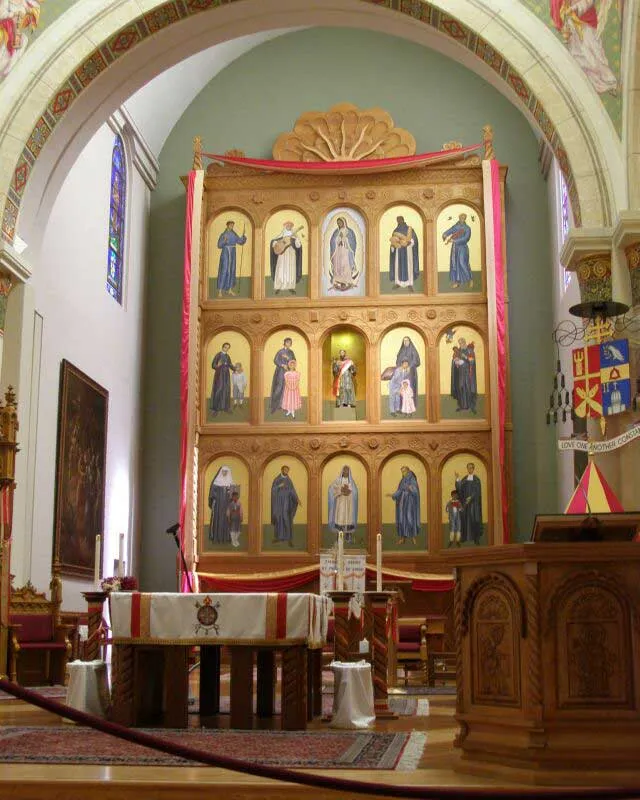
Fiesta de Santa Fe
Following her return to Santa Fe in 1693, a festival was enacted to celebrate the reclamation of the state. This annual thanksgiving procession continues today as the oldest Marian festival in the United States. La Conquistadora is carried in a procession from the Cathedral to Rosario Chapel, where masses are then held. Once the novena masses are concluded, the statue is brought back and Fiesta de Santa Fe festivities begin.
Parades and mariachis are a common occurrence at the Festival. The highlight of the Fiesta de Santa Fe is the burning of “Zozobra,” also known as “Old Man Gloom” an imposing 50 foot tall puppet that represents the problems and hardships of the previous year. Zozobra was designed by artist Will Shuster.
Renaming
La Conquistadora was given a new name in 1992; then-Archbishop Robert Sanchez gave her the new title of Our Lady of Peace. The name change has been ascribed to the need to ameliorate the tensions between the Spanish and the original inhabitants of the New World. She is also invoked as Our Lady of Conquering Love, which captures the spirit of the original title La Conquistadora.
St. Francis of Assisi
The statue of St. Francis, the patron saint of the diocese, was installed at the cathedral during the 1967 renovations.
Saint Kateri
Kateri Tekakwitha (1656–1680) is the first North American Indian to be beatified, and was canonized in October 2012. She was an Algonquian-Mohawk woman of New York State who converted to Christianity at an early age. The statue was created by Estella Loretto, a sculptor from the nearby Jemez Pueblo, and installed in August 2003. A plaque noting Kateri’s canonization was added in October 2012.
Jean-Baptiste Lamy
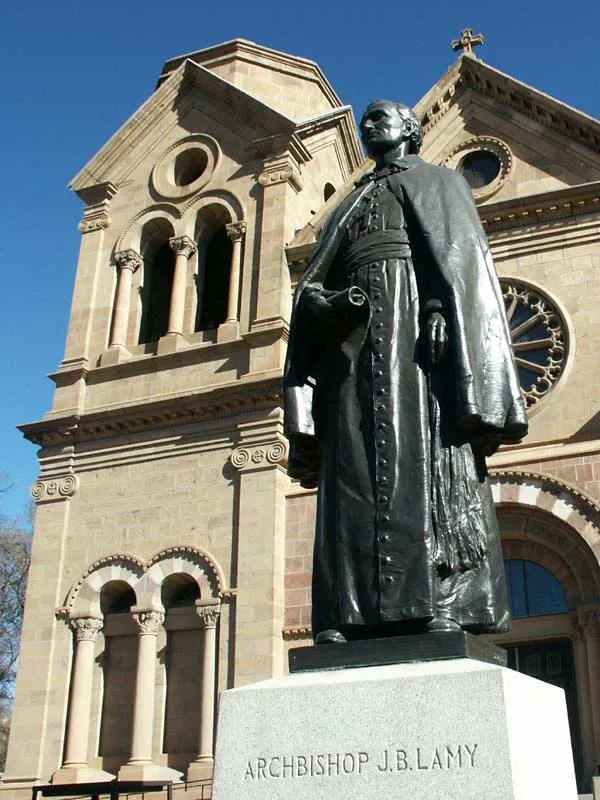
A bronze statue by Jeno Juszko honors Father Lamy (1814–1888), who was installed as the first bishop of the Diocese of Santa Fe in 1850. Under his direction, the cornerstone of the current cathedral was laid in 1869. He became archbishop in 1875, when the diocese was raised to an archdiocese. He retired in July 1885 to his residence north of town, known as Bishop’s Lodge. He is buried in the crypt beneath the cathedral floor. The statue was dedicated in 1915.
Stations of the Cross Prayer Garden
Fourteen life-size sculptures by Gib Singleton represent stages during the events in the hours leading up to Jesus’ crucifixion as developed by St. Francis of Assisi. The Prayer Garden is sited in the remnant of Bishop Lamy’s once-extensive gardens on the cathedral grounds.
Keystone
The keystone in the arch above the main entrance contains a triangle with the Tetragrammaton in Hebrew carved in it. An “old story” printed in The Fabulous Frontier, 1846-1912 alleges that this was Fr. Lamy’s way of thanking local Jewish merchants for their financial contributions towards the building of the cathedral.
Although there is evidence that Jewish merchants in Santa Fe helped fund the building, there are other examples of the Catholic Church using Hebrew symbols outside of Santa Fe that cast doubt on this story’s credibility. The specific representation of the Tetragrammaton inside a triangle symbolizing the Trinity can be found in several Catholic churches in Europe, including Goya’s fresco Adoration of the Name of God in the Cathedral-Basilica of Our Lady of the Pillar in Zaragoza.
Bronze doors
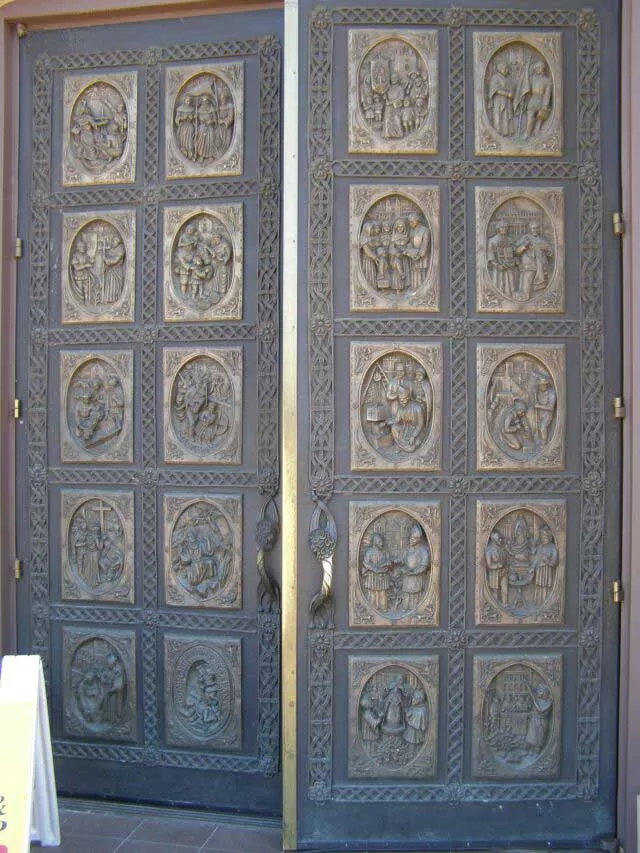
During the restoration of 1986, new doors were created, each with ten bronze panels that portray events in the history of the church in Santa Fe. Donna Quasthoff was the commissioned sculptor.
Interior - Nave
The baptismal font is in the center of the nave. Made of Brazilian granite, it was dedicated on June 3, 2001, by Most Rev. Michael J. Sheehan. The eight-sided form represents the 8th day, or Easter, marking God’s New Creation through the resurrection of Jesus Christ. The basin is a cruciform, with three steps representative of the 3 days between Jesus’ crucifixion and his resurrection.
The rill symbolizes the four Evangelists, who cast their nets to catch men. Its location directly between the doors and the altar is representative of the faith journey. To the south is the Ambry Cabinet, containing the oils used in the sacraments. To the north is the Easter Candle stand.
Surrounding the nave along the walls are the Stations of the Cross. The original artwork was done in New Mexico Mission Style. The French archbishops gradually removed the art and painted the walls white. In 1997, the current archbishop began to have the interior restored as it was historically. The Stations are created in Santero style by Marie Romero Cash. Roberto Montoya, a Penitent, carved the Spanish-style frames.
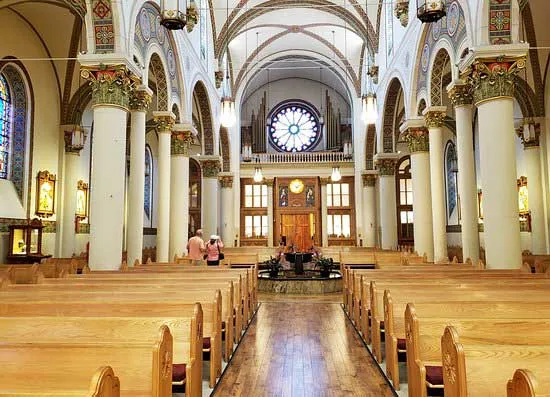
La Conquistadora Chapel
La Conquistadora Chapel occupies the north transept of the cathedral and is the oldest part of the building, having been incorporated from the previous Parroquia. It was built around 1717, about the same time San Miguel Mission was being rebuilt, and shares similar features. The chapel houses La Conquistadora, a wooden Madonna which was brought to New Mexico by Alonso de Benavides in 1626. The statue was removed in 1680 when the Spanish fled the Pueblo Revolt and then returned in 1693 during the Reconquista, when it was given the name “La Conquistadora”.
Behind the statue is a carved and gilded wooden reredos with oil paintings depicting various saints. The reredos consists of two altar sections dating from the mid-1700s which were salvaged from the old Parroquia. The pieces, previously used as side altars in the main cathedral, were restored in 1957 and stacked one on top of the other to form a reredos for the chapel.
The seven oil paintings also date from the 1700s. Four of them are attributed to Miguel Cabrera, one of the most important Mexican painters of the Baroque period, after a restoration of the paintings in 1976 uncovered Cabrera’s signature. During a recent (2000–2009) restoration, an older painting was found. On the left are the coffins of two early Franciscan priests. The chapel is listed as a “contributing property” of the Santa Fe Historic District.
Blessed Sacrament Chapel
The chapel is reserved for prayer. The window wall along the south transept was added during the 1986 renovations. Etched into the glass are depictions of the Apostles and the Holy Family, by the artist Andrea Bacigalupa. The stained glass windows in the chapel were made in France and represent the Eucharist.
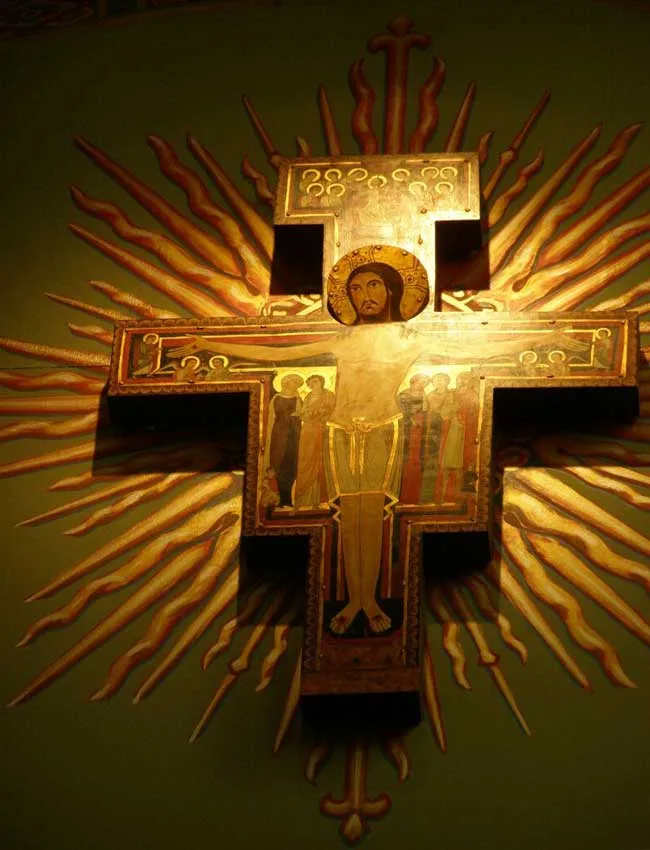
Sanctuary
Located in the east end of the nave is the sanctuary. Above the altar is the San Damiano Crucifix, a replica of the crucifix in Assisi, Italy. Tradition says that the Lord leaned down from the crucifix and said; “Francis, go and repair my house.”
The altar screen, a reredos, was created for the 100th anniversary of the cathedral in 1986. In the center is an 18th-century statue of St. Francis. He is surrounded by painted images of saints of the New World.
Directly behind the sanctuary is the entrance to the crypt. The sanctuary was redesigned in 1986 in accordance with changes in the liturgical worship. The Archbishop’s chair is located to the north, next to a pillar.
Cultural References
A fictionalized account of the cathedral’s origins is included in Willa Cather’s Death Comes for the Archbishop. Due to its prominent location off the plaza, many artists who have lived in or visited Santa Fe have captured its image in their work.
Feast Day - 12th January
Annual Feast Day of Our lady of conquest held on 12th January.
Mass Time
Weekdays
Saturdays
Sundays
Church Visiting Time
Contact Info
131, Cathedral Pl, Santa Fe,
New Mexico, NM 87501, United States
Phone No.
Tel : +1 505-982-5619
Accommodations
How to reach the Cathedral
Santa Fe Regional Airport in New Mexico, United States is the nearby Airport to the Cathedral.
Santa Fe Depot Rail Runner Station in Santa Fe, New Mexico, United States is the nearby Train Station to the Cathedral.

